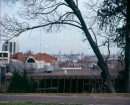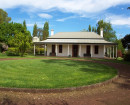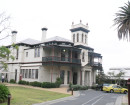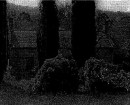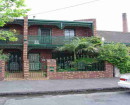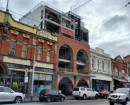Eulinya and Garden
48-50 Irving Road TOORAK, Stonnington City
-
Add to tour
You must log in to do that.
-
Share
-
Shortlist place
You must log in to do that.
- Download report
Statement of Significance
Eulinya house and garden, 48-50 Irving Road, Toorak, is of Local (potenital state) significance historically and architecturally:
- as a superb combination of house and garden design that epitomises the underlying theme of Arts & Crafts architecture where the design of the house is at one with its garden setting and thus is particularly evocative of the architectural firm, W&R Butler's reputation for significant Arts & Crafts architecture and garden design (Criterion E1)
- an externally well preserved representative of Toorak's special significance over time as the chosen residential domain of some of the nation's most influental figures and, in the case of this house, a new phase of Toorak's development in the immediate post First War period that saw the breaking up of the large estates and the emergence of a new type of urban mansion set in smaller but more articulated grounds (Criterion A4)
-
-
Eulinya and Garden - Physical Description 1
(as assessed from the street)
This large house occupies an unusually large triangular-shaped, promontory site at the junction of Irving and Albany Roads, with associated extensive garden and landscaping, also designed by Walter Butler.
This two-storey clinker brick and render house is set at an angle to Irving Road, and parallel with Irving Rd, to present a large formal garden area and main receiving rooms to the north aspect, facing away from the main entry. It has projecting gabled room bays, balconies, timber-framed fenestration with multi-pane glazing, and a steeply pitched main roof clad with terracotta shingles. The massive hipped main roof has gabled and hipped secondary roof forms, major chimney elements (particularly the asymmetrically placed chimney on the south elevation) and bowed roof vents. The south elevations has some classical revival elements, including arched top-lights to major windows with radial mullions, and some fine wrought-iron balustrading in the Georgian manner.
However, the design character derives from the English Arts and Crafts style that draws upon English domestic works of previous centuries, with emphasis on the roof form and associated dormer forms and chimney stacks, the expression of natural materials such as the brick and terra-cotta shingling, the simulated rough construction of brick fragments in the render, projecting brick headers and perforated brick walling at the gateway.
The title to the `Australian Home Beautiful' review of the new house in 1927 was `a Twentieth Century Interpretation of Old English Architecture'. The 1927 illustrations of the property reveal the following.
Unusual north elevation with twin bowed room bays, each with a conical shingled roof, set either side of a recessed balcony section, bowed parapet over and tall twin angled chimney stacks. This creates the axis for the landscape design beyond, centred on the rose garden to the north. Here there a brick fish pool with perforated brick screen similar to the gateway walls. The bowed bays a banded with brick and render, such that the recent replacement of the brick infill panels between each window opening has not changed the striped treatment conceived originally
The staircase is a grand geometric space in the manner of Georgian houses, with Ionic order columns on the perimeter of the space. The entry door is set in a basket archway, with radial mullions in the top light and panelled side lights.
GroundsThe property is surrounded by a high, mainly added, ornamental pier and panel perimeter fence constructed of face brick and render to match the original gateway. Decorative brickwork to the wall resembles that of the house. Entrance through the perimeter wall is via a pair of gateways, with massive gate piers topped with iron lanterns and ornamental wrought-iron gates. The ironwork of the vehicular and pedestrian gates is in a strapped Jacobean pattern, following the English Arts & Crafts theme. Two contemporary cast-iron lamp posts are in the adjoining nature strip. Observation of 1988 survey plans and recent aerial views show that t the garden layout has not changed, with the main lawn and terrace areas remaining as built, with new elements in service areas. The old trees from the Ottawa estate also remain in the north of the grounds.
The garden is an integral part of the house design and includes areas of formal lawns, paved terraces, a pool, rose gardens and hedges. Termed a Tudor garden by the `Australian Home Beautiful' article of 1927, the layout follows the general scheme of a garden laid out for the first Tudor monarch, Henry VII, with a series of garden enclosures or compartments linked by covered walks, and galleries: illustrating the emerging Renaissance influence on the prevailing medieval garden.
`Australian Home Beautiful' 1927 article shows the site layout:
- basalt pitched kerb and channel at entry to (gravelled) forecourt with two gate pairs;
- masonry perimeter fence for one bay to the north of the wall segment curving into the gateway, hedge shown for the rest;
- garden compartments with gravel paths, including:
the triangular lawn to the west of the house surrounded by clipped privet; wild garden contained by a hedge, with hedge archways into it (dotted possible future tennis court here) and established trees; the main lawn to the north of the house surrounded by flower beds; the radial bed rose garden to the north-east of this, at the other side of a small pool, with brick paths; and kitchen garden, garages etc to the east and south-east of the house served from the Albany Rd entry.The 1991 garden study stated:
`A large gravel drive bordered by shrub beds creates a grand and spacious entrance through large gates in the new boundary wall. The apex of the site is filled with a woodland and there is a tennis court immediately to the north of the house. At the rear is. the original lawn, elaborate brick paving and symmetrical pergola walks on either side. A formal sunken walk with raised side beds and an antique seat backed by the weeping `Ulmus glabra' "Camperdownii" is the focus for this part of the garden. To the south east there is a new swimming pool. The garden has been extended into neighbouring properties in the same style but with different materials.'
Major Plantings
`Quercus robur'
`Wisteria sinensis'
`Camellia' cvs
`Buxus sempervirens'.
`Rhododendron' cvs
`Ficus macrophylla'
`Rosa' cvs
`Ulmus glabra' "Camperdownii"
`Quercus palustris'
`Erythrina' sp
Herbaceous perennials (Various)
Annuals (Various)
InteriorNot inspected.
The 1927 plan shows:
- porte-cochere entry on the south,
- living room on the south-west,
-sun room and terrace on the north-west,
-projecting bays containing the morning and dining rooms set either side of the central verandah on the north facade,
- hall and main staircase up the centre axis of the house, and
- the servants quarters in the east wing (longer than the west wing) next to the service yard.
Eulinya and Garden - Integrity
(as assessed from the street)
Generally very good: as seen from the street there has been little change to the house and grounds.
The perimeter wall has been extended from near the gateway to surround the house, in a matching form. The property land has been extended to the east from the 1927 extent, the tennis court built as envisaged in 1927, a small house erected where the garden bins were once located to the north-east of the rose garden, and a pool where the kitchen garden was.
Inspection has not been allowed but comparison of building application drawings with the original contract drawings and those published in 1927 show that there has been little change to the main south elevation, facing the street. The rear (north) elevation has had minor changes in fenestration, with the bold bowed window bays and main roof forms intact.
Internally changes have occurred as is typically the case, in bathroom and kitchen areas and removal of the servant presence in some of the subdivision. The main internal spaces (entry and main receiving rooms) appear to be near to original (1927) but this should be verified by inspection.
Eulinya and Garden - Local Historical Themes
8.4.1 Houses as a symbol of wealth, status and fashion
6.3 Constructing capital city economies
Heritage Study and Grading
Stonnington - Heritage Overlay Review - Amendment C5, C6
Author: Graeme Butler & Associates
Year: 2003
Grading: A1Stonnington - Conservation Review City of Prahran
Author: Context P/L
Year: 1993
Grading: A1Stonnington - Prahran Conservation Study Identification of Buildings & Areas of Major Significance
Author: Nigel Lewis & Associates
Year: 1983
Grading:
-
-
-
-
-
ARMADALE PRIMARY SCHOOL
 Victorian Heritage Register H1640
Victorian Heritage Register H1640 -
ARMADALE HOUSE
 Victorian Heritage Register H0637
Victorian Heritage Register H0637 -
CLENDON LODGE
 Victorian Heritage Register H0561
Victorian Heritage Register H0561
-
'YARROLA'
 Boroondara City
Boroondara City -
1 Bradford Avenue
 Boroondara City
Boroondara City
-
-






